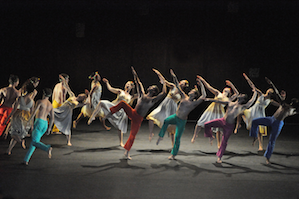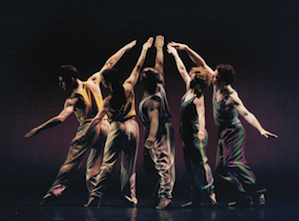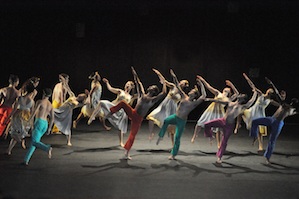
Photo by Peg Norpinski
It should surprise nobody that the stellar choreographer Mark Morris has a great ear. As music director of the last weekend’s Ojai Festival, (and Ojai North, which opened beautifully Wednesday under the auspices of Cal Performances at UC Berkeley), Morris gathered two fantastic bands, the Bad Plus jazz trio and the American String Quartet, to accompany his Mark Morris Dance Group at sold-out Hertz Hall. Earlier, the sextet red fish blue fish played John Luther Adams’ Strange and Sacred Noises, a multi-locale, outdoor intriguer with drums, gongs, sirens, and xylophones, in a free concert at Cal’s verdant Faculty Glade.
The Hertz show included the 1993 Mosaic and United, one of the best pieces Morris ever made up, with the Americans playing the Henry Cowell String Quartets III and IV excerpts. The five dancers deserve recognition: Sam Black, Dallas McMurray, Maile Okamura, Lauren Grant, and Noah Vinson.
The world premiere of Spring, Spring, Spring, Morris’ take on Igor Stravinsky’s The Rite of Spring, which is (in case you haven’t heard …) marking its centenary, was much anticipated. But alas, unlike the Benny Goodman blockbuster, Spring, Spring, Spring doesn’t Sing, Sing, Sing, nor — except for interludes of partnering that feel like a cross between a folk dance and a jitterbug — does it really Swing, Swing, Swing.
Choreographically, it’s interesting, and the company’s dancers are superb. But from Mark Morris one expects more. And dare it be said, from a man who tells wonderful stories through the bodies (and body) of his company, there was hope of a dramatic arc.

Stephanie Berger
It didn’t have to be a story about ritual or sacrifice or a chosen one; Morris had already said he thought that particular type of attachment to Stravinsky’s Rite was bogus and not what the composer had intended. But it seemed, unhappily, as if Morris was restraining himself from superimposing any interpretation on the music. If this was essence of Stravinsky — or of Morris — it fell short, giving the lie to the idea that a dance, given the right music, can just be. The dancing, each measure of it perfectly phrased and rendered, meandered — here a line dance, there a series of partnered twirls; on the floor a lone male; now a folksy circle, women turning steadily with their arms curved in front of them, ballet-style.
The music, reconceived two years ago by the Bad Plus based on Stravinsky’s own two-piano version — also used for dancemaker Paul Taylor’s The Rite of Spring (The Rehearsal), by the way — seemed to fade as the dancing went on. There were explosive moves at accented moments, with space-gobbling leaps and lifts, but they were soon damped down. There were a few references to iconic moves and moments of various other danced Rites. Lauren Grant’s feet fluttered as her partner lifted her, marking a disquieting, almost taunting musical phrase; in another, a male dancer echoed the flattened pose of one of Taylor’s Rite … Rehearsal characters.
Maybe it was the self-effacing nature of Elizabeth Kurtzman’s off-white, empire-waisted dancing dresses that made them the choice for this piece. Frankly, they’re frumpy, and the garlands the women wear on their heads look like an afterthought. The women’s garb seems out of sync with the men’s bare chests and jeans in bright colors.
None of this is intended to degrade the thought that went into the premiere; maybe it’s a commentary on how when we focus so much attention, such anticipation, on one piece, one moment of musical history, it cannot, should not, bear our weight. Nor our wait.

